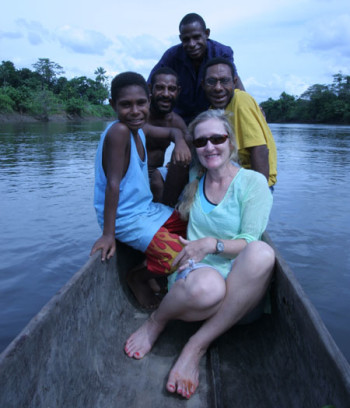
Nancy Sullivan on the Karawari River 2007 with sons Leonard, Edward, Christian and Jeffrey (Photo credit: Susan Salinger)
The Pig in a Garden: Jared Diamond and The New Yorker series:
Art Science Research Laboratory’s iMediaEthics and SavageMinds.org is simultaneously cross-publishing on both web sites, a series of essays on the controversy surrounding Jared Diamond’s New Yorker article, “Annals of Anthropology: Vengeance is Ours.” The essay series titled,The Pig in a Garden: Jared Diamond and The New Yorker, is written by ethics scholars in the fields of anthropology and communications, as well as journalists, environmental scientists, archaeologists, anthropologists and linguists et al., and edited by Rhonda Roland Shearer, Alan Bisbort and Sam Eifling. Each contributor’s mission was simple: To examine Jared Diamond’s article, and The New Yorker’s decision to publish it, through the lens of their own discipline. We think you will agree that these issues will not soon be put to rest. As Nancy Sullivan writes in her contribution, part of the reason for this series is to reclaim some of the ground among general readers lost to “experts” like Jared Diamond. With this series, imediaethics.org and SavageMinds.org seek to capture that wider general audience for writings about anthropology. Sullivan’s essay is first in the series.
* * * * * * * * *
I am an anthropologist who has lived in Papua New Guinea (PNG) for more than twenty years, most of these in the highlands. In 2002 I also taught a course in PNG war and peace, so the concept of Melanesian vengeance is not unfamiliar to me, either personally or academically. My understanding of Jared Diamond’s point in the piece “Vengeance is Ours” is that revenge is natural. It’s a Hobbesian message for the twenty-first century: humans are hardwired for revenge and require a social contract to prevent madness and mayhem. Savages are rational, because they also have rules to obey and urges to forfeit for the greater peace. But because tribes are such small units, Diamond seems to say, their rules lie closer to the human impulse.
Apparently the Melanesian social contract is somewhat thinner than the European one, superficially veiling the urge for revenge and permitting its satisfaction in controlled acts of “payback.” People like Daniel Wemp, for example, live but a step away from the pre-Leviathan Eden, where all men were islands and under no social constraints. Diamond invites us to see the difference between Wemp’s smug vendetta and the lifelong frustrations of Diamond’s father-in-law, who could never experience revenge for his family’s murder during the Holocaust. The modern state fully thwarts our urge, whereas tribal edicts do not — presumably even tribal societies within the state of Papua New Guinea. In an interesting anti-sentimental twist, Diamond also tells us that tribal people are ultimately happy to submit to a state apparatus, if only to be freed at last from the cycle of violence and payback.
If indeed Papua New Guineans are so eager to throw off the shackles of tribalism and finally live in peace, Daniel Wemp can now thank Diamond and The New Yorker for alerting the state apparatus of his crimes.
No one will ever find ‘Daniel Wemp’
I want to make three points here. First, that Diamond has seriously endangered this subject, whom he identifies by real first and last name, by claiming his responsibility for a series of murders. Beyond the Nipa tribe and the Southern Highlands Province is a thoroughly modern state of Papua New Guinea for which these acts constitute murder.
The second point follows from the first. The field of anthropology has a code of ethics that includes “informed consent” — a not-incidental notion that if you use people for research purposes, they must know the risk involved, the nature of the project, how the data will be used, and how it will be publicized. In short, they should have the choice to remain anonymous. In a pinch, when these conditions cannot be met, you have to mask the subject’s identity.
But we know that Diamond’s piece does not actually come from the “annals of anthropology,” or at least not professional anthropology. That field has a distinct method, something called the ethnographic method, coined by Brownislaw Malinowski in New Guinea ninety years ago to prod the discipline out of the armchair and into the field for a minimally required period of time.
Informed consent has been an important topic to anthropology since Margaret Mead sat down for a chat with young women in Samoa (and Derek Freeman told us she got it wrong). But none of us would be discussing this now if it hadn’t been for Mead’s savvy decision to publish her first book with William Morrow, for a general audience, and thus bring cultural relativism into living rooms across the English-speaking world. Americans were especially blessed by her Redbook columns, where we learned that childhood, adolescence and even gender roles are not, as had been imagined, biologically determined. It was Mead who first taught the wider public about the tenaciousness of culture.
But it is our fault as anthropologists that no one has picked up the ball Mead dropped, and produced enough popular cultural anthropology in recent years. Jared Diamond is just filling the vacuum we left. No one seems to realize anymore that the field is not about making generalizations about humankind, but about describing the defining differences between cultures. It is not about expanding biological knowledge, nor defining the line between culture and biology, but about understanding the diversities of what is manmade, what is not natural after all. Anthropology teaches us about the power of world views.
Diamond has been fantastically successful at bypassing particulars for the single European worldview of history, a worldview that professes to treat all societies with equal respect, but which, in fact, takes a remarkably Victorian approach to culture. Much like armchair anthropology, Diamond’s anecdotal evidence of other peoples is used to support an evolutionary view of culture, where social progress and moral growth bring us to a somewhat imperfect (but more advanced) present. We miss the idyll of a tribal past, but we are too sophisticated now to ever return.
Though we might wonder how Daniel’s society came to revel in killing, ethnographic studies of traditional human societies lying largely outside the control of state government have shown that war, murder, and demonetization of neighbors have been the norm. Modern state societies rate as exceptional by the standards of human history, because we instead grow up learning a universal code of morality that is constantly hammered into us: promulgated every week in our churches and codified in our laws. But the differences between the norms of states and of Handa clan society are not actually so sharp. In times of war, even modern state societies quickly turn the enemy into a dehumanized figure of hatred, only to enjoin us to stop hating again as soon as a peace treaty is signed.
There are whiffs of L. Ron Hubbard, Joseph Campbell, and even Jeffrey Sachs to this logic. Great masters of the sonorous single narrative, by which all manner of irritating complexities are put to rest. In the end, dear readers, it’s a small world after all.
Excess and restraint
This brings me to my third point. Diamond gets it wrong. Any thesis based on Melanesian justice as being retributive in the Western sense is absolutely wrong. It is solipsistic simplification.
Anthropologists most frequently define groups and their borders by whom they fight. There has been a long history of anthropologists studying conflict in Melanesia as a means of describing group identity, governance, and the social contract that is community. C.H. Wedgewood made the first stab at synthesizing this material in 1930, arguing that warfare in Oceania serves to integrate and knit together a community by defining the enemy – the Other. But the watershed years for studies of warfare in Papua New Guinea (PNG) really were the 1970s, when a cadre of anthropologists produced seminal ethnographies on the causes, forms and function of violence, especially across the highlands (see Barth 1975, Berndt 1971, Brown 1978, Hallpike 1977, Koch 1974, Meggitt 1977; Scaglion 1979, Schieffelin 1979, Sillitoe 1978, Strathern 1977, Vayda 1976, e.g.).
The triggers and causes of inter-tribal conflicts are never the same. Any pretext can initiate a fight, but this may be only a superficial altercation. It is the older, submerged reasons that make the blood boil and really sustain a war. Only the most assiduous research can tease these out of the gossip, bragging, historicizing and campaigning that surround warfare everywhere. Ronald Berndt’s 1962 classic of highlands warfare, Excess and Restraint, is more about excess than it is about restraint, seeming to imply that there are far more fights than strategies for keeping peace. Similarly, Ryan’s 1959 work on the Mendi (near Daniel Wemp’s region) calls inter-clan fighting volatile and chronic (1959: 268), and Glasse (1959) says the nearby Huli are hell-bent on continuous war. It can all look pretty rogue and bloodthirsty from the outside – like Homo sapiens in some pre-modern state of self-interest. But none of these writers would suggest that this is the whole story.
In the words of one Melanesian expert:
“[N]o worthwhile comment can be made on the cause of a particular [inter-clan] clash without inside knowledge of the longterm relationship between the contesting parties, or about the bearing group memories have on the conflict. Empirical accounts of the formal procedures, frequency, weaponry, and strategy of war, what is more, have only partial value in explaining conflict if little can be said about consciousness and underlying beliefs. There is no better introduction to this cognitive side to the matter than through analyzing notions of revenge. Killing was not carried out for the sheer love of it; it was virtually always an act to repay or satisfy some material grievance. But vengeance against enemies, in particular, was almost invariably backed up by appeals to legitimacy. Whether taken at the socially acceptable moment or not, it was normally sanctioned by those helping, perhaps paying the killed, or by those sharing the drive to assuage the sense of loss in ongoing ‘revenge warfare’ (Trompf 1994: 28-9).”
Even when war attracts hotheads and loose cannons (and Diamond tells us “The New Guinea Highlands are full of aggressive men seeking revenge for their own reasons”), and even when warriors seek unsanctioned revenge, there is still the distinction between legal and illegal bloodshed. Violence must have social legitimacy greater than one’s own personal ambitions. It is hard to glean whether Diamond knows this or not from comments like the following:
“Daniel was proud both of the aggressiveness displayed by all the warring clans of his Nipa tribe and of their faultless recall of debts and grievances. He likened Nipa people to ‘light elephants’ “: As Diamond quotes him in his New Yorker article, “They remember what happened thirty years ago, and their words continue to float in the air. The way that we come to understand things in life is by telling stories, like the stories I am telling you now, and like all the stories that grandfathers tell their grandchildren about their relatives who must be avenged. We also come to understand things in life by fighting on the battlefield along with our fellow-clansmen and allies.”
Berndt also recounts some of the most fantastic and improbable boasts of war (see Knauft 1999: 118).
If Diamond would have us understand that a revenge culture in highlands PNG is also rule-bound and rational, closer to a Babylonian law or the Torah than a modern state, we must also assume that it cultivates a system of punishment intended to end a conflict. This is consistent with an evolutionary view of culture in general, where an eye for an eye emerged in response to the endless personal vendettas posing a threat to the social fabric. In the earliest forms of statehood, defining tit for tat was a means of finishing warfare rather than perpetuating it. But again, listen to the highlands experts. Glasse says of the Huli that they have no idea of lex talionis. A man tries to inflict a greater injury than that which he has suffered. Moreover, the people who suffer as a result of vengeance do not accept their injuries as just or appropriate; they too seek counter-vengeance, and the conflict is unending (1968: 68).
This is precisely why there are so any young highlands men willing to do battle. As Glasse tells us, “nearly every [Huli] man nurses a grievance that can precipitate war” (Ibid: 88).
Revenge in the Western sense simply does not exist in the highlands of New Guinea. Outsiders are constantly left dumbfounded by the open-endedness of the system. But the Melanesian worldview is no simple subject to tackle, even for battle-hardened anthropologists. Payback killings and apparently indiscriminate acts of revenge are as common as prodigious (even self-destructive) acts of generosity, gifts without promise of comparable return, and infinite strategies of deflecting blame. None of these conundrums is separable in a Melanesian worldview.
Behind the Melanesian pidgin term “bekim” (payback) lies the presumption that life, punctuated by dangerous feuding and competitions, colored by the excitement of reciprocities and trade, is to be apprehended as a continuous interweaving of gains and losses, giving and taking, wealth and destitution, joy and sorrow, vitality and death (Trompf op cit:1).
Smoke in the Hills, Gunfire in the Valley
Rosita Henry has a particularly apt 2005 Oceania article (Henry 2005) by this title about the Nebilyer fight in the Western Highlands that broke out in 1990 and ran for almost a decade. It also serves to illustrate Trompf’s point above, about the inevitability of violence as part of – not a rent in – the social fabric. Outsiders know the Nebilyer war from Connolly and Anderson’s third film in the First Contact trilogy of films, Black Harvest, which was shot while the couple lived on Joe Leahy’s plantation and bore witness to the opening salvos of the fight. I would assume Diamond himself is familiar with the film. Henry deals explicitly with peacemaking strategies and the complexities of negotiating compensation throughout a conflict, and she walks us through some of the event analyzes provided by participants themselves. That is, she cites the explanations they give for paying certain parties, and not paying others, and for electing certain causes of the conflict while ignoring others.
It’s an excellent paper that rings true to me because I was living in Mt. Hagen with one of the participant clans, the Penambe, at the time; I am familiar with some of the folks’ quotes; and I was a business partner to the person whose song lyrics form part of the title. Maggie Leahy Wilson’s plaintive song says: “There’s smoke in the hills / Gunfire in the valley / A woman is wailing / A loved one is killed / My heart is aching / My Heart is aching.” It’s about heartache, Henry reminds us, which always makes highlands violence regrettable, especially to women, even if we concede that it is integral to the warp and woof of highlands life. She goes on the demonstrate how, like it or not, peace compensation strategies during and after warfare are as important to the community as traditional exchange ceremonies. Along with Rumsey, Merlan, and M. Strathern, Henry argues that warfare is not a mark of social degeneration (sensu Hobbes) but a structural component of highlands society, even as it is bemoaned and avoided by most highlanders.
Alan Rumsey (Rumsey 1999), Francesca Merlan (Merlan and Rumsey 1991) and Marilyn Strathern (M. Strathern 1972) all have written about peace negotiations in the Western Highlands as highly social events, as layered and important as moka exchanges, funerary feasts and bride price ceremonies. But moka wealth exchange partners are never the same people you oppose in battle, so the relations defined there are very different. In battle, for example, direct and primary enemies never compensate each other; they compensate their allies and their minor enemies who may have lost lives and property. In some cases this seems counter-intuitive (to people like Diamond), but it is part of a strategy to ensure future alliances, and not to seal an absolute peace. Special transactions can secure longer-lasting peace, however, and help settle a matter more conclusively. These transactions require lengthy discussion, in which every trigger event, and then every secondary cause, is re-examined for latent significance and hidden motives. First the key causes are revealed to the communities and left to percolate in gossip for awhile, to accumulate variant recollections and memories of past causes. It’s what we call “planting the seed” in tok bokis or euphemistic tok pisin: a proposition is placed on the table for a while, and public conjecture accumulates around it. Finally, the best orators from all sides will reap the fruit of this and present it in a formal debate, literally redefining the terms of the fight as they do so. Their eloquence can weave insinuation into clever parables that may, if successful, satisfy all parties while leaving acceptable loopholes for the future. Consensus, and definitely not emotions, seals the conclusion of these peace negotiations. People like Daniel Wemp might walk away with one interpretation, and his enemy may take away another, but neither view shakes the tree of consensus.
In the Nebilyer fight, for example, one of the trigger events was a mistake. A Ganiga man shot dead his clansman, a security guard, after a theft on Joe Leahy’s coffee plantation. Initially, the Ganiga assumed a Kulka had shot the guard, and they retaliated against the Kulkas. But they actually chopped up a Kulka ally, a Poi Penambe man, and this elicited a fierce alliance between Kulkas and Poi Penambe. In turn, the Ganiga brought in the Ulka as their allies, re-activating a series of debts and obligations between these sometimes-allies. Ultimately, the internal compensations were labyrinthine: Ulkas paying each other, Ganigas paying Ulkas, Poi Penambe paying Kulkas, and Ulka Kundulge paying the Ganigas (because it turns out the man who shot the security guard was not Ganiga but Ulka Kundulge after all).
In the midst of all of this, Henry cites the Poi Penambe man who was chopped up by the Ganigas and survived. His complaint is clearly made in the hope of eliciting sympathy from the listener, fully aware that his problem is “unjust” at some level, but knowing that the social contract, and not his personal emotions, will prevail.
He said, “The Kulkas are putting the pressure on me and my tribe you see, because I was axed. I was axed and the fight started. Probably about 30 or 40 men were killed, Kulkas. And the pressure is on me now, May father and my small tribe, Poi Penambe, you know. They’ve been given pigs and money and all that thing, and they’re still putting pressure on us today…They want cash now. I have to initiate that by putting in a couple of grand, which I haven’t got. They [Kulka] sort of feel that because they [Ganiga (Ulka)] chopped you and we supported you and we lost our men in the fight and then you’re still alive, we should be compensated by you for our men (Henry 2005: 438).”
This is “restorative” justice, or what Alan Rumsey prefers to call transformative justice (Rumsey 2003) – and it has nothing to do with either personal or collective revenge. It is about finding a way forward, as painful as that may be. Indeed, I imagine the Poi Penambe man still harbors resentments from that period.
In addition (and this has to do with the Daniel Wemp case) these analyses are made all the more complicated by new factors of the cash economy: a cash crop income (coffee, in this case) and the resentments over whose land is used for cash crops, and the obvious jealousies of an emergent class system. Some people are vastly wealthy in the Western Highlands today, while others are modern peasants. Any substantive discussion of Wemp’s story, and his gloss of events, must take these factors into consideration. Like the Western Highlands, the Southern Highlands context involves the segmentary politics of clans, and the new hierarchies of cash.
Swallowing half-truths
The problem is that Papua New Guineans are more and more likely to describe warfare in ways that Europeans prefer to understand it.
When hostilities break out between two sides, the outsider is apt to regard the situation as arising de novo. And when Melanesians are asked today why given fights have occurred, they themselves are prone to give deceptively simple answers, to do with land-grabbing, for example, theft of pigs, rape or perhaps sorcery. Rarer reasons are known to have been voiced: such as women stealing, elopement, jilting a marriage suitor, threats to a trade specialty, or even insults directed at gardens by a visiting tribal leader. Perhaps the most common type of response, though still simplistic as it remains, is to give a narrative account, an informant telling how A was angered by the actions of B and led a raiding party to kill B or one of his associates (and did so in a way worth telling), the deeper or long-term reasons behind the act of revenge being barely touched. After years of interaction between “subject” and “ruling” peoples, these replies to outside researchers have taken on a stereotypical quality…[and] such replies have been absorbed into pre-existing explanatory frameworks to vulgarize the already dissolving subtleties and complexities of traditional perspectives. When it is blithely accepted, however, that Melanesians view human conflict in terms of disconnected, separate episodes, with acts that require revenge, followed by acts of vengeance (or satisfaction), supposedly forming a self-contained unit of affairs, only a half-truth has been swallowed. (emphasis added) (Ibid: 32)
Traditional justice in New Guinea is not based on the Western model of retribution, but on that of restoration. Restorative justice is far from the eye-for-eye, tooth-for-tooth blood-lust Diamond attributes to Wemp and would wish for his father-in-law; it has more to do with repairing the social fabric. Restorative justice as the tribal dispute logic is also being increasingly formalized in PNG’s statutory law. In village courts it has always been the leading form of jurisprudence: Whatever custom makes the best peace is the best option. But even the greater legal apparatus of PNG has more and more customary law folded into it these days.
For women in particular, it continues to be a very unsatisfying form of peace. As traditional clanswomen were subject (rather like Sharia law) to their husband’s whims, and more likely to be thrown in as part of a compensation payment than avenged for injury, they are beginning to seek more equable status in the courts these days. None of this has been easy (see Garap 2000), and some of it has been remarkably successful in recent conflict resolution cases (see Rumsey 2000, 2003). But it continues to resist the Judeo-Christian concept of a bounded and autonomous individual before the courts – someone wholly responsible for his or her action – because that product of Western civilization simply does not exist in Melanesia.
Women are struggling with this across the developing world, and anyone familiar with non-Western worldviews would be able to appreciate the steeper uphill battle of feminism outside the Western world. Not long ago, for example, a young woman from the Southern Highlands of PNG, not far from Daniel Wemp’s home, took her own father to court to establish her jural individualism (and won): It was determined that she could stay at university in the capital and not, as her father and clan had determined, be part of a compensation package to an enemy clan.
Restorative justice
Let me try to explain restorative justice with a personal example from the Western Highlands. In 1993, I was kidnapped in Mt. Hagen (which is about 60 km from Nipa) by a gang of young men who were members of my hosts’ enemy clan. I was living with the Elti Penambe, and these were Kopi clansmen living just next to Penambe clan boundaries on Kuta Ridge, outside of Mt. Hagen town. The gang held up a car carrying me and two tourists on our way to town, as we passed through their customary land. We were really just caught up in traditional Penambe-Kopi tensions made more fraught by the nearby Nebilyer fight. Our kidnappers did not target us per se, but as accessories to the Penambe cause. The tourists were an Australian father and son visiting from Port Moresby, and I was a familiar Penambe resident at the time. In the course of the day we walked through the bush, were held at gun and knife point, and finally, after threat of a gang rape, fought the captors, after which I ran away and was molested by one of them
During the year of court proceedings that followed the incident, clansmen and friends did what they could to dissuade me from pursuing the case, not so much because they couldn’t understand my anger, but because they said it would jeopardize the inter-clan peace. How could I be so selfish? Even when the enemy tried to substitute one young man for the culprit (someone who could do the jail time because he wasn’t in school), I was (for some reason) dogged in my need for retribution. The kid who put a knife to my neck was going to be the kid who paid the price, I insisted.
As my clansmen hammered out their own precarious peace, including an exchange of pigs and money that never involved me, I went back and forth from the courthouse in town with sympathetic cops from the lowlands who openly despised Hagen people and made no bones about roughing up the young man in his cell.
Eventually, a public prosecutor helped me apply a new restorative justice law when the young man was convicted: In exchange for the detention time he had served, I would accept a collection of kina compensation from the clan. This new restorative clause seemed fair to me, because the kid had spent a year in detention anyway, and I was in fact angry at the clan for harboring the gang and not assisting us to bring it in.
By the time a conviction was made, I was thoroughly disgusted with my “host” clan as well as these neighbors, and entirely on the grounds of Western “fairness” I had deeply internalized. At one point, while still living in the village, we’d put out word that there was a reward for some of the cargo stolen from the tourists, in particular their video camera. When the gear came back, at the hands of one of the culprits himself, I snickered and told them I’d lied, there was no reward – and my hosts were furious with me for the deceit.
They had not been angry in my behalf at the lies we were continually told by the clan representatives (that they had no idea who these kids were and no notion of where they might be hiding). And they were not appeased in the least when we found the gang had left in the camera a home video that, when played, revealed the clan representative to be part of the gang and pledging, in local language, that the next time they kidnapped me they’d kill me after all.
During this period, as a bushfire in the enemy land grew out of control and threatened to cook our gardens, I was told to leave the clan land for fear, with the fire, of starting a renewed war. Joe Leahy (himself deeply embroiled in the Nebilyer fight) offered me safe haven in one of his town flats.
I distinctly remember two offenses I took very personally during this period, even as I knew better than to do so. At one point, the enemy clan leader was accompanied by a Peace Corps volunteer, a very nice young man working in the region, when he came to visit one night and plead for me to drop the case. I had by now seen him in a home video (and still keeping this fact secret), so when I grew impatient and accused him of lying, the Peace Corps volunteer quite disingenuously came to his defense, asking, “Don’t you think you’re being little culturally insensitive, Nancy?”
At another time, my business partner and host, with whom I had written several grant proposals for women’s projects, told me I was aggravating clan tensions and putting the poor accused lad’s family in great distress by not dropping the case. So much for female solidarity, I snarled.
Finally, when the young man was convicted and returned with the clan counselor on the designated day, with the agreed-upon fine, there was no one to receive him at court, and the two walked back to the village, never to be pursued again. I took churlish satisfaction to find the young man repeatedly re-offended afterwards, and was pleased to hear he was caught for robbery and thrown into jail sometime later.
But every time I passed the rest of the gang on the streets of Hagen, for years afterwards, they would wave and shout friendly hellos to me like we were old pals. And I’ll never forget one afternoon when I waited in the courthouse for our hearing and the young man was led past me in handcuffs. “Hey Nance, yu orait?” he said, or some such unaffected greeting. I stood there for a long time trying to understand how he could be so friendly, so impersonal about his arrest.
In the end, it was this depersonalization that got me through the ordeal, because every Hagen woman I might have commiserated with preferred to say “Get over it,” and “What makes you special?” I was a cipher in a group war, and nothing, not even the assault, was a personal gesture.
The fact that I was a woman only further diffused my “rights.”
It hit home one day, several months into the trial, when the lowlands policeman assigned to my case came to pick me up for the proceedings. He had the case file on the seat beside him, under his holstered gun, and I took a quick look out of curiosity. He was a nice guy; I liked him, even though he had been among those who relished bashing the kid when he was first picked up. (The most disturbing instance I saw came when they pulled him out of the cell, for my benefit, and stood him before a low desk, where they lay his penis and gave it several boot whacks – certainly not to be confused with an expression of feminist solidarity.) When I opened the case file I noticed that the charge against this kid was “theft,” and nowhere did it mention the attempted rape. “What?” I must have asked. The cop told me yeah, he’d forgotten, and they’d tack that on afterwards when they got a conviction.
Ultimately, I learned what the Poi Penambe man interviewed by Rosita Henry knew too well. I could cry forever about my personal wounds, but I’d evoke no sympathy until I worked for a larger social reparation.
Patterns of aggression
In conclusion, I would say that anthropologists are not the only elephants who remember past injuries. Conservationists and development workers in PNG have similar memories. In 1992, for example, World Wildlife Fund US, on whose board Diamond sits, sponsored an eco-forestry project in the Kikori Delta region of PNG. Chevron was then drilling for oil in the region and had become concerned about publicity surrounding its environmental effects, so they enlisted the help of the WWF to green up their image.
Internal Chevron documents at the time suggested that “WWF will act as a buffer for the joint venture against environmentally damaging activities in the region, and against international environmental criticism.” The eco-forestry project would be an alternative to the industrial logging made possible by laying Chevron’s oil pipeline, and would be additionally supported by the MacArthur Foundation, the U.S. State Department and the World Bank’s International Finance Corporation.
The problem was, however, they did not source their timber from the logs felled by Chevron, but instead from a local company that was known to be harvesting mangrove forests. Unfortunately, harvesting mangroves is illegal in PNG, for conservation reasons. When the sawdust hit the fan, though, WWF US proved unrepentant. Apparently (in a remarkable foreshadowing of this debate) the state of Papua New Guinea did not mean much to the project sponsors.
As the Sydney Morning Herald reported, “Jared Diamond, a WWFUS board member and Pulitzer Prize winner … says that what is happening at Kikori is ‘sustainable logging of mangroves.’ Diamond adds that, regardless of whether it is illegal ‘if it can be done on a sustainable basis then by all means do it’” (Rowell 2001).
Enough said.
NANCY SULLIVAN: Director, Nancy Sullivan and Associates, Ltd. does anthropological consulting, qualitative research, survey design, report writing, training and workshop design for a range of private and public entities. The field teams consist of DWU graduates from the Department of PNG Studies (former students of ethnographic research methods]. In 2009, she served as Team Leader, Karawari Cave Arts Expedition, The National Geographic Society Magazine, March 2-28, covering the cave art project National Sullivan & Associates have been conducting since 2007 with National Geographic and Guggenheim support.
REFERENCES:
Banks, C., 2000. “Contextualizing sexual violence: rape and carnal knowledge in Papua New
Guinea,” in Reflections on Violence in Melanesia, ed. S. Dinnen and A. Ley, Annandale, NSW: Hawkins Press, pp 83-104.
Barth, F. 1975. Ritual and Knowledge among the Baktaman of New Guinea. New Haven: Yale University Press.
Berndt, R.M., 1962. Excess and Restraint. Chicago: University of Chicago Press.
Doherty, T. and S. Garap, 1995. Women and customary law in PNG, Documents from the IWDA’s 1995 (pre-Beijing conference) Beneath Paradise Collections (unpublished).
Feil, D. 1987. The Evolution of Highland Papua New Guinea Societies. Cambridge: Cambridge University Press.
Frankel, S. 1986. The Huli Response to Illness. Chicago: University of Chicago Press.
Garap, S. 2000. “Struggles of Women and Girls—Simbu Province, Papua New Guinea,” in Reflections on Violence in Melanesia, ed. S. Dinnen and A. Ley, Annandale, NSW: Hawkins Press, pp. 159-171.
Glasse, R.M. 1959. “Revenge and Redress among the Huli,” Oceania 5:273ff.
1968. The Huli of Papua: a cognatic descent system. Cahiers de l’homme NS, 8, Paris.
Goldman, L.R. 1981. “Compensation and Disputes in Huli,” in R. Scaglion (ed), Homicide Compensation in Papua New Guinea. Law Reform Commission of PNG Monograph 1, Port Moresby, pp. 56ff.
Goddard, M. 1996. “The snake bone case: Law, custom, and justice in a Papua New Guinea village court.” Oceania.
Hallpike, C.R. 1977. Bloodshed and Vengeance in the Papuan Mountains. Oxford: Oxford University Press.
Henry, R. 2005. ‘Smoke in the Hills, Gunfire in the Valley’: War and Peace in Western Highlands, Papua New Guinea. Oceania 75 (4): 431+.
Knauft, B.M. 1985. Good Company and Violence: sorcery and social action in a lowland New Guinea society. Berkeley: University of California Press.
—–1990. “Melanesian Warfare: a theoretical history,” Oceania 60(4): 250ff.
—–1999. From Primitive to Postcolonial in Melanesian Anthropology. Ann Arbor: University of Michigan Press.
Koch, K-F. 1974. War and Peace in Jalemo: The Management of Conflict in Highland New Guinea. Cambridge: Harvard University Press.
Lederman, R. 1986. What Gifts Engender. Cambridge: Cambridge University Press.
Meggitt, M.J. 1977. Blood is Their Argument. Explorations in World Anthropology. Palo Alto: Stamford University Press.
Merlan, F. and A. Rumsey, 1991. Ku Want: Language and Segmentary Politics in the Western Nebilyer Valley, Papua New Guinea. Cambridge: Cambridge University Press.
Ploeg, A. 1969. “Government in Wanggulam.” Verhandekingen van het Koninklijk Institut voor Taal-, Land –en Volkenkunde 57, The Hague.
Rappaport, R.A. 1967. Pigs for the Ancestors. New Haven: Yale University Press.
Reay, M. 1959. The Kuma. Melbourne: Melbourne University Press.
Rowell, A. 2001. “No way to save trees.” Sydney Morning Herald, 02/03/2001.
Rumsey, A. 1999. “Social segmentation, voting, and violence in Papua New Guinea.” The Contemporary Pacific 11(2):305-333.
—–2000. “Women as peacemakers–A case from the Nebilyer Valley, Western Highlands, Papua New Guinea.” In S. Dinnen and A. Ley (eds), Reflections on Violence in Melanesia. Leichhardt, NSW: The Federation Press, pp. 139-155.
—–2003. “Tribal Warfare and Transformative Justice in the New Guinea Highlands.” In Sinclair Dinnen, Anita Jowett and Tess Newton (eds.) A Kind of Mending: Restorative Justice in the Pacific Islands, Canberra: Pandanus Press, pp. 79-93.
Scaglion, R. 1979. “Formal and Informal Operations of a Village Court in Maprik.” Melanesian Law Journal 7(1): 116-29.
Schieffelin, E. L. 1976. The Sorrow of the Lonely and the Burning of the Dancers. New York: St. Martin’s Press.
Strathern, A. 1977. “Contemporary Warfare in the New Guinea Highlands: Breakdown or Revival?” Yagl-Ambu 4 (3): 135-46.
Strathern, M. 1972. Women in Between: Female Roles in a Male World: Mount Hagen, New Guinea. London: Seminar Press.
Trompf, G.W. 1994. Payback: The Logic of Retribution in Melanesian Religions. Cambridge: Cambridge University Press.
Wedgewood, C.H. 1930. “Some Aspects of Warfare in Melanesia.” Oceania 1:1ff.







Nancy, you wrote a wonderful informative personal and powerful article, shinning light to clarify for me aspects of the Diamond, New Yorker ethical mess. Thank you.
i had read tny diamond article and found my way here thru columbia journal review. thanks for this article. the diamond article was fascinating and the contraversy enlightened me to how far from any truth sources like tnr can be. you have added much to my understanding of png and the issues with diamond as a source.
Having read ‘Guns, Germs and Steel’ and working my way through ‘Collapse’ I can say that I’ve admired style with which Jared Diamond has managed to draw together and consolidate the work in various fields to construct his arguments.
Having read the criticism of his article in the New Yorker, I’m very disappointed in what appears to be a very clear case of a failure to take his task seriously and apply himself appropriately. Damning, in short.
The following is a not particularly well constructed series of sentences, representing more ‘thoughts out loud’.
“I distinctly remember two offenses I took very personally during this period, even as I knew better than to do so.”
Nancy, I think you’re missing the point here, and I say this in a friendly way that is normally indicated with a smiley emoticon.
It’s perfectly normal to ‘take offence’ in the manner you describe. I’d say it’s rather futile to try not to. There was no interest in how you experienced the event and the Peace Corp volunteer was a rather blunt, simplistic and unskilled person. If they could not identify why you think and feel how you did, then they lacked cultural awareness and sensitivity themselves. Place yourself in Sydney, Australia and you become the PC (no pun intended) volunteer. Image trying to explain to someone from PNG why the justice they seek is not going to occur. A similar comment being made by you in that context would be grounds for a formal complaint by the victim of the offence.
Compassion and empathy are requirements in such instances, regardless of where you are and what is happening. Expecting that across various cultures in not foolish, inappropriate or imperialistic.
Having feelings about various events is normal. Stick with it. Contextualising them is fine, but submerging them is pointless.
I have no particular knowledge of the area or cultural practises and would agree that Diamond’s presentation of the ‘facts’ would appear to be incorrect. What I am curious about is the extent to which the ongoing violence and clan fighting is the result of people who feel they’re not considered in the ‘peace’ that eventuates. If the frequency of what I’m assuming you call non-legitimate violence is high, relative to the legitimate violence, then it would appear to me that the solutions invoked are nothing more than a papering over of the conflict and ultimately requires change.
It is this, I guess, that most interests me. Population and resource stress certainly cause violence, but is the mechanism of conflict resolution in the area insufficient also seriously deficient?